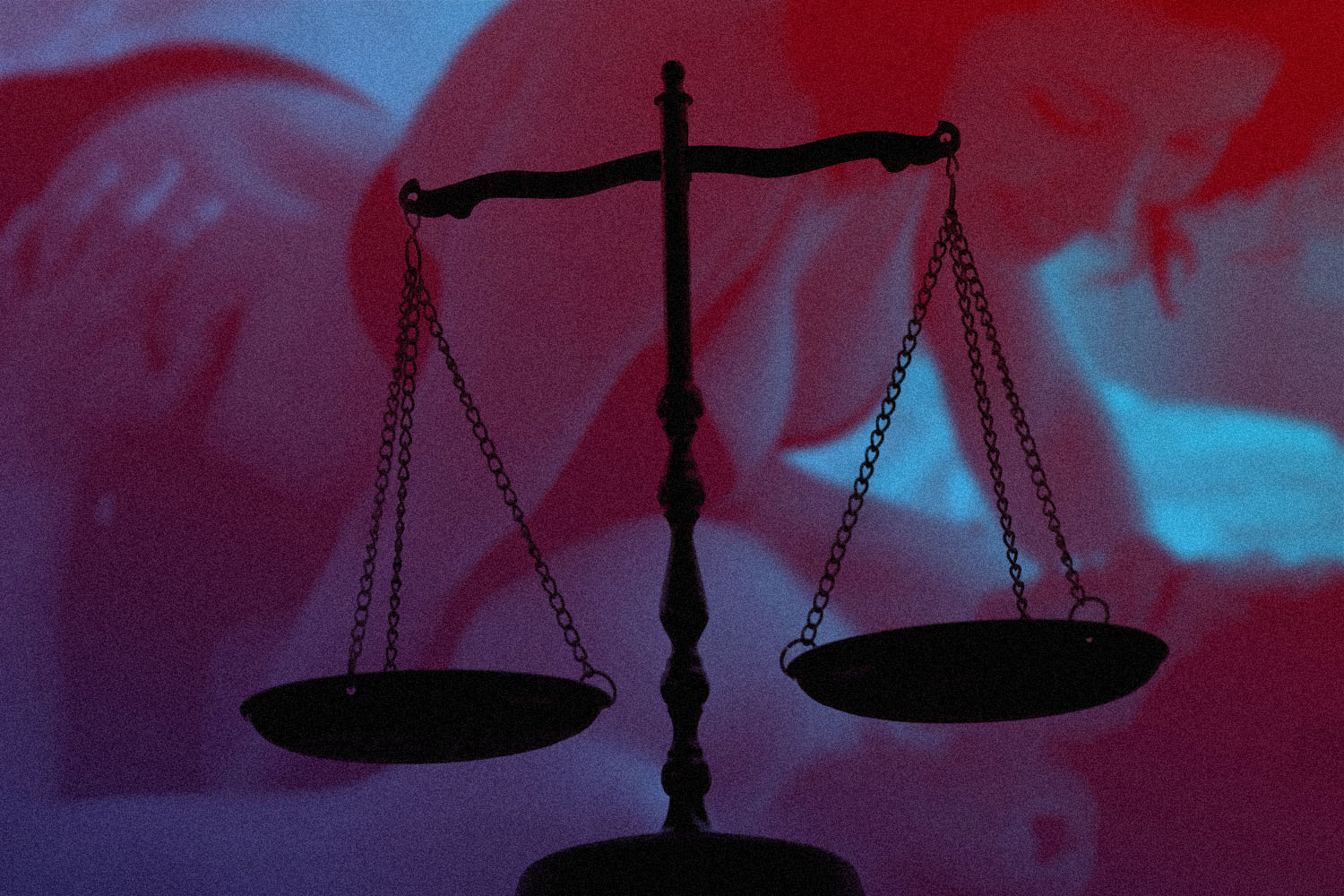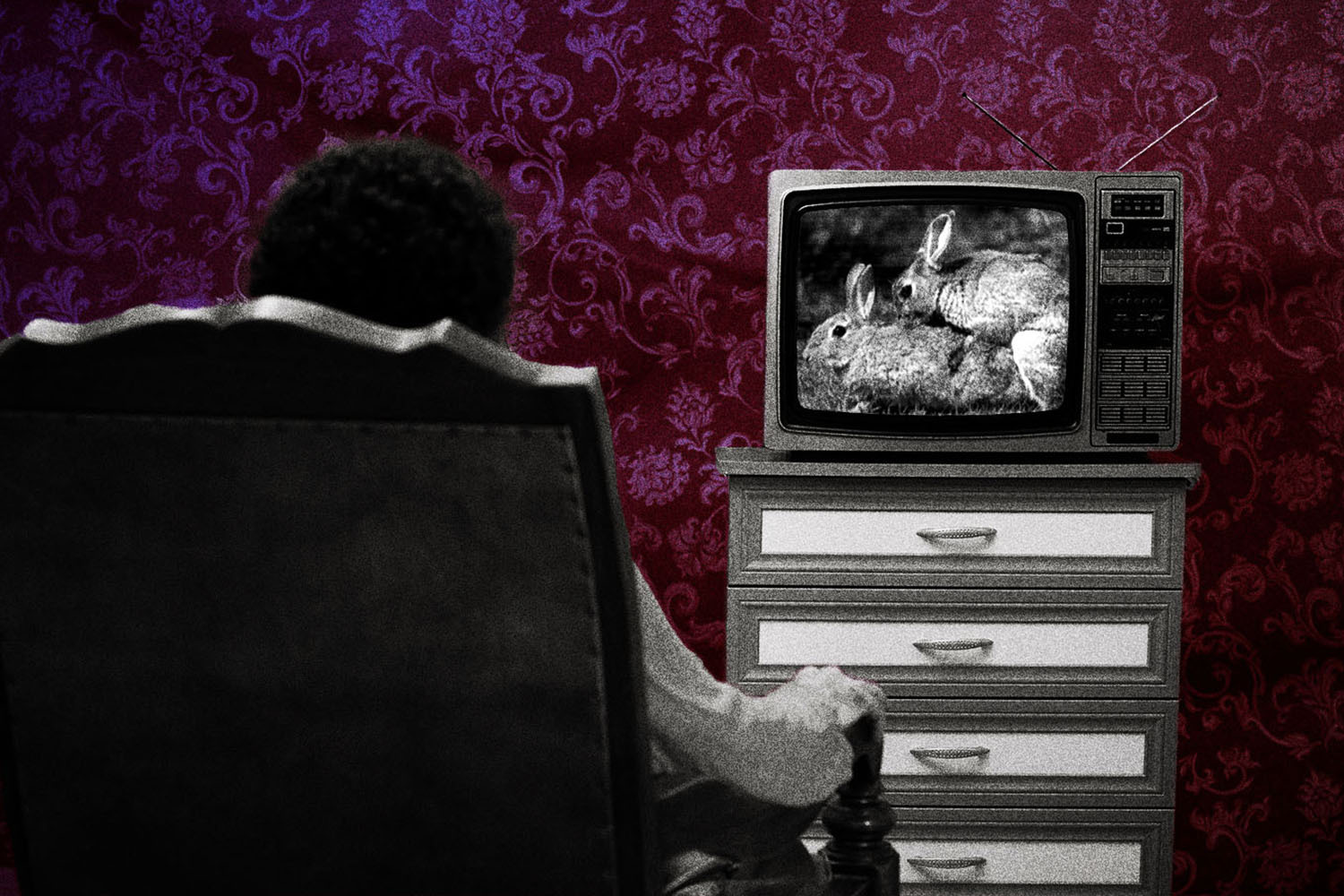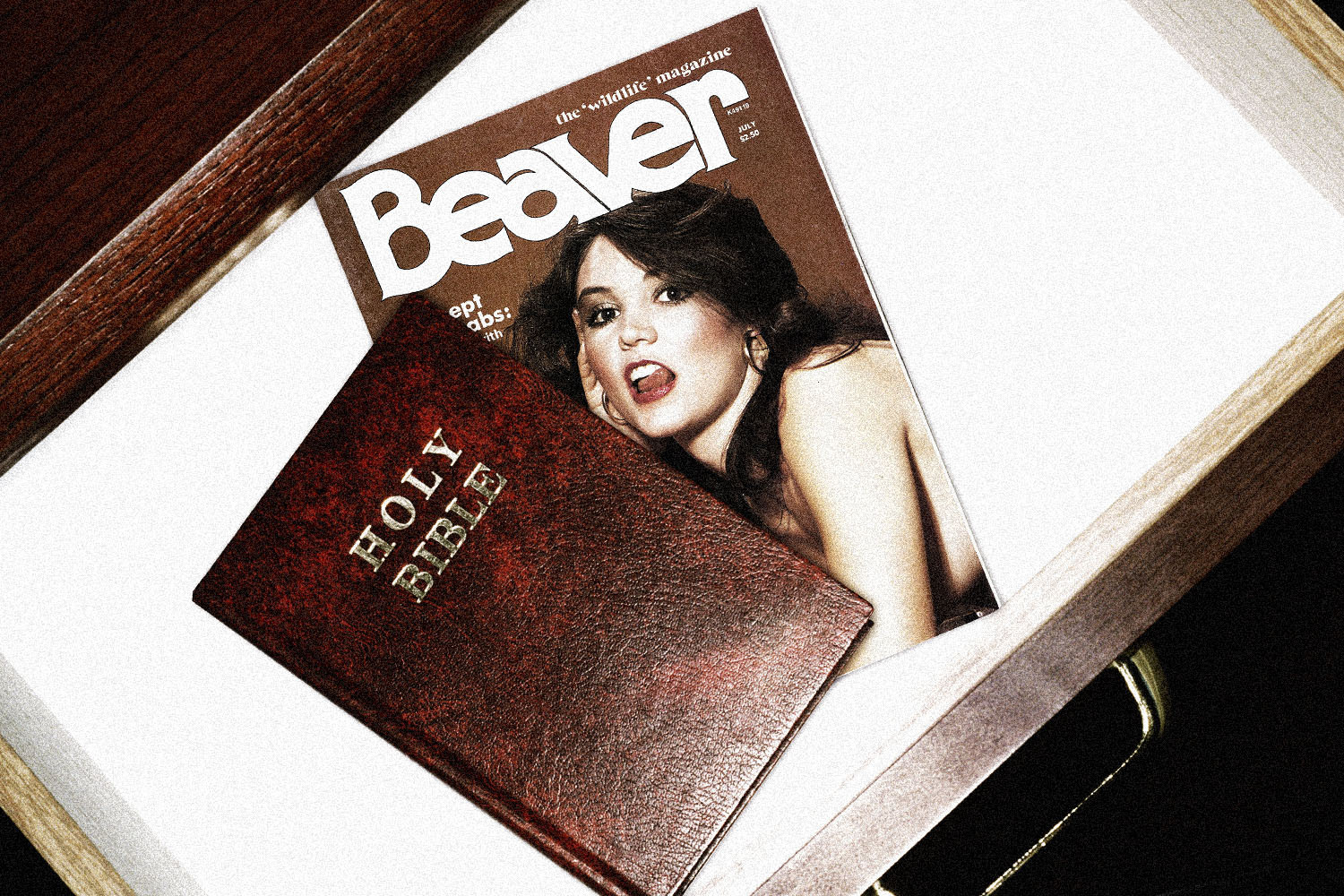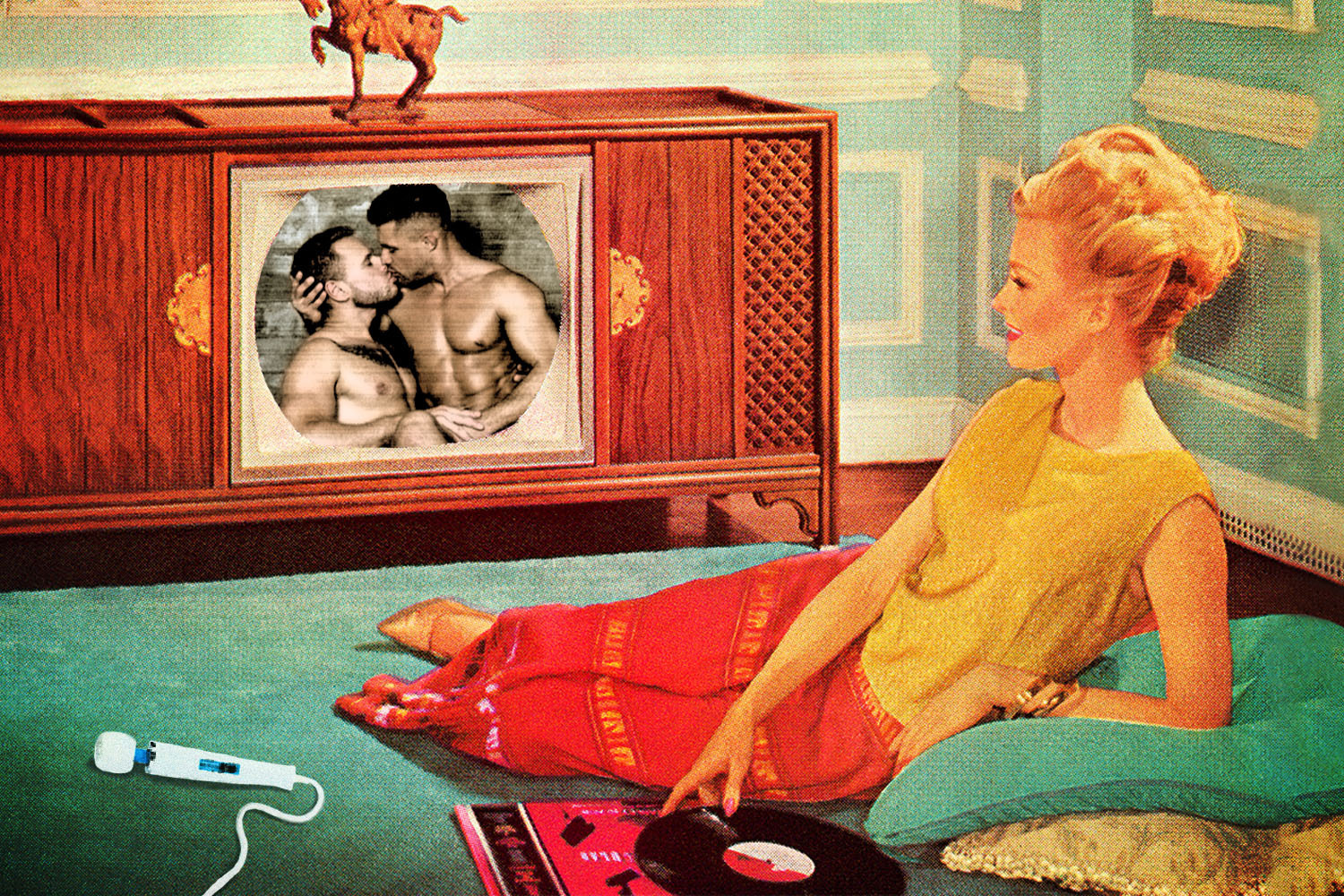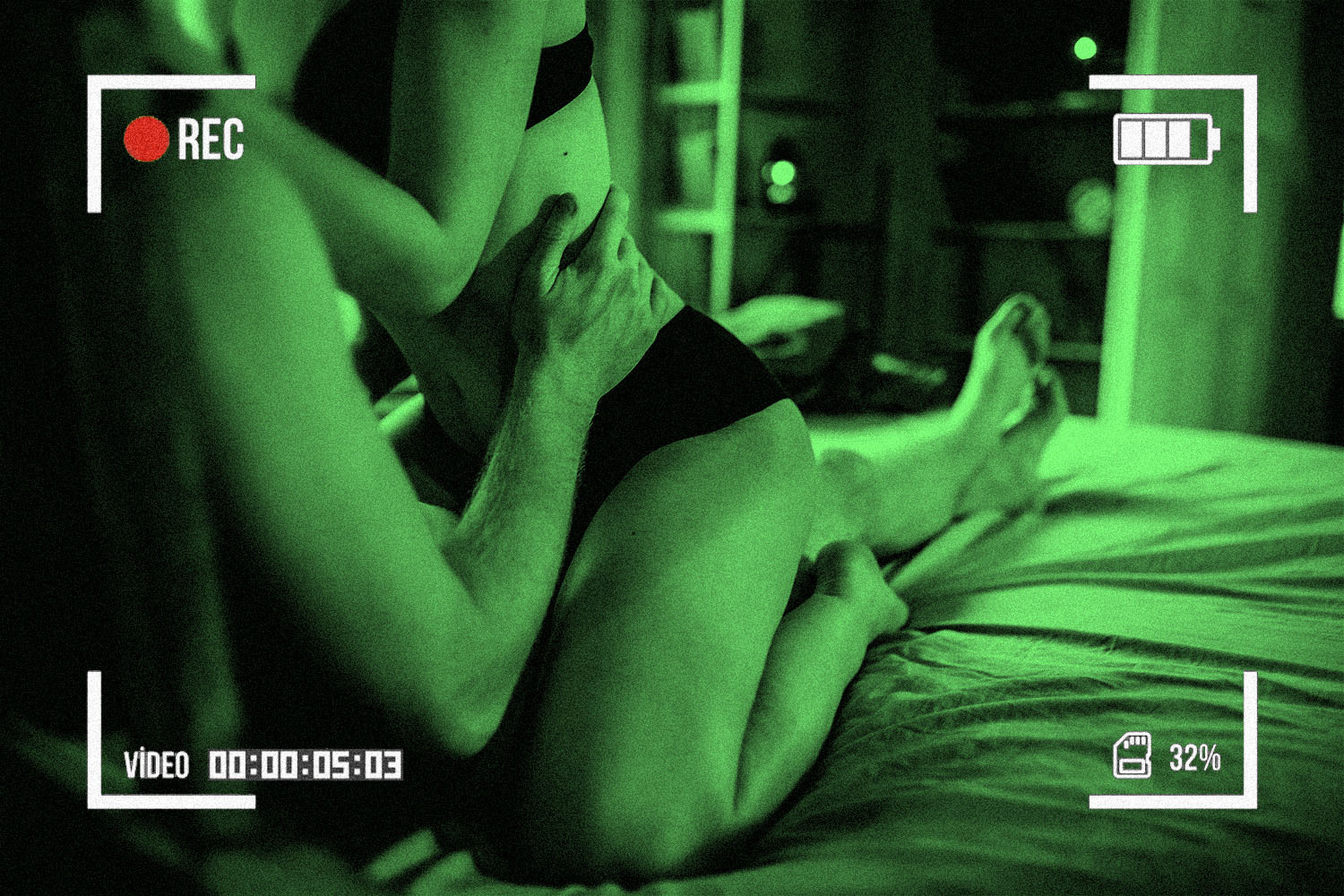“Before I was even in eighth grade, I’d already heard about bukkake,” says porn producer and performer Lisey Sweet. She recently learned that her teenage stepchildren are already familiar with the word, too. In fact, the term is so widely known that mainstream shows, games and even public intellectuals feel comfortable throwing it around. Sweet puts mass awareness of this niche sex act down to bukkake’s disproportionate visibility in porn, and porn’s disproportionate impact on all of our sexual vocabularies — as do many other porn insiders and cultural researchers alike.
But bukkake didn’t gain its initial foothold in the pornosphere because people were clamoring to see a gaggle of guys ejaculating on one woman. It wasn’t even a cheap or logical jump forward from prior popular content. Instead, the rise of bukkake and a handful of other now ubiquitous terms — like gokkun (cum drinking) and scissoring (perpendicular partners rubbing their vulvas against each other) — is the byproduct of two colliding forces: A porno renaissance fueled by cultural and technological changes that made it possible to pump out any type of porn and make bank on it, and the whims of a few punky producers who wanted to see how far they could push the limits of porn in this environment. This free-wheeling experimentation shaped our culture more than many of us care to admit — and also drove some of these producers to ruin.
The birth of bukkake
Bukkake in particular was the brainchild of Jeff Mike, who stumbled into the adult industry in the mid ’80s when some random dude approached him on Los Angeles’s Ventura Blvd. to ask if he wanted a job. Mike was, as he puts it, “a typical 20-something punk a-hole with no sense of direction,” who’d been working sporadic phone sales gigs. So, he figured, why not see what the opportunity was? He wound up in a warehouse, shrink-wrapping the latest porn VHS tapes for distribution. The role didn’t last long, but it introduced him to the business side of the adult industry, and led him to a sales job for a big porn distributor. “It was the easiest thing I’d ever done,” he says. “I went from basically trying to shove pens down people’s throats to just calling somebody, saying ‘I have three new X-rated videos,’ and people couldn’t wait to buy them.”
Mike wasn’t just drawn in by the easy money behind-the-scenes porn work offered, but also by the culture that came with working in a heavily stigmatized industry. “I came from a punk background and kind of grew up on the streets,” he says. “Working in porn was kind of like going to a punk show. You’re with a bunch of outcasts — everybody was very unique — and it feels comfortable. I mean, it probably didn’t for everybody. But it did for me. It felt like home.”
Frequent police raids, which bedeviled the industry through the ’80s, reinforced his attachment to the porn world. (Although porn is legal in America, obscenity is illegal to this day. This is a tricky legal term, as its definition depends on what the average person in a community would find offensive. Historically, censorial forces used this vagueness to crack down on ostensibly legal porn producers, arguing that their content crossed a murky line into illegal offensiveness.)
“The owners of one company would call everyone else and say, ‘We just got hit,’” Mike recalls. “So, our owner would say, ‘Pack up all your stuff and we’ll all meet at TGI Fridays.’ We’d all leave the building [completely empty for the cops] and drink at the bar until the coast was clear.” It was a bonding experience. But it also made him feel like his misfit family was under threat by jackbooted thugs, which made him all the more eager to push moralists’ buttons. “The more somebody tells me I can’t do something, the more I’m going to do it to prove a point,” he says.
The rate of raids decreased dramatically in the mid ’90s, as the Clinton administration had no interest in supporting them. Around the same time, industry wonks figured out how to use the still-nascent internet to make direct and discreet sales to consumers, drastically expanding the smut market. “By the early 2000s, porn was being shot at a greater rate than ever before,” John Stagliano, founder of Evil Angel and a prominent industry fixture of the era, once told me, and new studios formed almost daily to meet seemingly endless new demand. “The consequences of failure were not so great, because you could do just about anything and still make some money.”
Mike, who’d gradually drifted from sales into content creation, got his own studio at this pivotal moment and brought Jim Powers, a fellow punk from his area, onboard as his go-to director and key creative collaborator. Most of the new content flooding the market at the time struck him as dull and formulaic — a rote cash grab or a bid to build mainstream legitimacy for the industry by playing it totally vanilla-safe. “It was almost offensive to me,” he says. “Maybe that’s because of my punk background. I thought all commercial music was really shitty, but I respected bands that put out music they loved, knowing they were never going to get airplay or money.”
“To me, an adult movie is supposed to be dirty,” he says. So, he made it his mission to stand out within the constant barrage of new content by creating consciously smarmy, boundary-pushing content. Over the years, he came up with a ton of promotional taglines for his studio, but two of his favorites were “We’re keeping porn in the gutters,” and “Porn you can still be ashamed of. “
His team sat around coming up with ridiculous ideas and titles. “It was probably a lot like how they write Family Guy,” Mike says. “Five idiots sitting around bouncing ideas off of each other.” He wasn’t actually into most of the movies they made, “but it was fun to come up with absurd titles and box copy, which were probably only amusing to me. I love that process, especially when you can really do whatever the fuck you want. It’s really fun to experiment then.”
Mike and his crew were not alone. In fact, a mini arms race started between a handful of studios at the time who were all constantly trying to outdo each other to keep standing out and pushing the bar. Some, like Stagliano, say they were driven by their own personal tastes — creating their own wildest dreams or drawing out inklings of fetishes to their logical conclusions. (Stagliano played a huge role in the rise of anal porn, and the industry’s focus on the tuchus in general.) Some were responding to the wildest consumer whims. (“Creampie” scenes, which focus on an internal ejaculation, often lingering on leakage, came into prominence in this era following a uniquely concerted fan campaign.) Some imported ideas from abroad and decided to see how they’d play in North America. Powers got his hands on a 1986 Japanese adult video that featured something called bukkake, which Mike found so extreme and fascinating that he just had to try it — with dozens of guys recruited via newspaper ads and an underground hotline. Mike likened the process of shooting bukkakes to hosting secret punk shows. Naturally, he loved it. But they all spitballed their way beyond into a constant flow of ever-wilder on-camera firsts.
“We were the first company to do bukkake, gagging and pissing movies,” Mike says of his wins in the great novelty race. Another studio motto read: “We don’t follow trends. We create them.”
“If my movies were profitable, that was great,” he adds. “But that was never really my goal. I was always very experimental. I always just wanted to see how far I could go.” However, he found that the more disgusting the content was to him, the more fans ate it up, lining his pockets.
“I used to yell at my then-wife because I couldn’t balance our checkbook — there was too much money in our account, too many numbers,” Mike recalls. “I felt like I didn’t need anybody. I could do anything. So, that’s how I acted. Did I become an arrogant ass? Yeah, I probably did.”
Feeding on the edges
None of the producers active in this wild era knew for sure which of their experiments would resonate with consumers, and they often struggled to understand why something took off after the fact. Sometimes, they were probably tapping into latent markets, providing something not even consumers knew they wanted until they saw it — and then they needed more. Sometimes, the sheer shock factor of content generated sales; people just had to see what all the fuss was about, even if they weren’t into the content in the end. But whenever a producer struck it big with some new category, studios across the industry would emulate it to cash in on the trend — an inevitable cascade effect that rapidly increased its visibility on porn sites across the internet.
“By sheer repetition,” says Joseph Slade, an Ohio University media studies professor and a specialist on the history of adult content, “their terminology moved toward common usage.”
Once a new trope or term hits a point of critical saturation in the porn world, it inevitably bleeds into pop culture as well, especially through “edgy” music, movies, and television. “A culture always feeds on its edges to renew itself,” explains Slade. “It can perhaps seem cool to do so.”
Porn’s cultural contributions are often incredibly sticky because, as advertising expert and entrepreneur Cindy Gallop puts it, “we are all completely and utterly fucked up about sex.”
It was probably a lot like how they write ‘Family Guy.’ Five idiots sitting around bouncing ideas off of each other.
Jeff Mike
Sex ed almost always uses solely clinical terms to discuss the bare-bones hydraulics of cis-heterosexual reproduction, leaving no room for people to learn about the wild diversity of human sexuality, or about the right to pleasure within sex and how to achieve it. Beyond that, few people have any spaces to talk and learn about the wild realities of sex. Many folks the world over don’t even have access to limited sex ed. In the absence of any resource, people turn to porn for reference points and raw vocabulary — even when they know, as adult insiders often stress, that it is fantasy, not documentary. Or, as Gallop puts it, “Because we don’t talk about sex in mainstream spaces, the language of porn has rushed in to fill that vacuum.”
No one knows for sure what the net effect of this influence is on individuals, or our culture. But Gallop argues that porn’s terminological power is at least conceptually problematic, because it sets the tone for how most of us can talk about sex. It can also distort our perception of what other people are actually doing in bed, leading us to believe something is actually common or desired when, in fact, it may just be a punk-stunt experiment that escaped the smut lab. (Gallop is trying to address this issue with Make Love Not Porn, a streaming platform full of videos that show all types of people having sex on camera the same way that they have sex in their everyday lives, and developing accessible vocabulary for everything on display to facilitate more and fuller sexual conversation. But, she acknowledges that it’s unclear how much impact she’s had.)
But Mike does not seem terribly interested in considering how, if at all, the leakage of his ideas into the zeitgeist has affected individual, or our collective, sex lives and lexicons. “I had no idea it would change the culture,” he says. “That was never something that I was trying to do.”
The end of an era
Of course, the environment that sustained Mike and his peers’ wild envelope pushing could not last forever. During the 2000 U.S. presidential election, George W. Bush openly telegraphed his intention to ramp back up obscenity trials if he won — and that December, before he was even in office, Los Angeles cops busted porn producer Seymore Butts for obscenity, citing his extreme anal content, including fisting videos. A few months later, they nabbed Mike in for his bukkake and pissing videos. Butts and Mike wriggled out of charges, paying minimal fines — and the Bush administration had to sideline its moral crusading to focus on its response to the September 11th 2001 terror attacks, and on the war on terror and invasions of Afghanistan and Iraq that followed. Still, the incidents sent a chilling shiver through the industry, with many major labels pulling their extreme lines out of circulation, and most producers receding to the safety of vanilla sex.
“My attorneys constantly told me that I could get raided again,” says Mike. “But I figured they were being overcautious, so I didn’t put much stock in their warnings. I thought I was a king — I was untouchable. If the government came after me again, it’d be no big deal. I’d just get hassled and have to pay a fine again and then it’d all be fine.” So he, like a few of his punkish cohorts, bucked that industry trend and doubled down on extreme content into the early aughts.
But in the mid-aughts, the Bush administration had enough breathing room — and a new attorney general dedicated to adult industry crackdowns. The Department of Justice launched a dedicated anti-obscenity task force, the FBI formed a smut-focused squad, and they both proceeded to haul in almost every big boundary-pushing name for high-profile trials, including Stagliano and Mike. They, and most other producers, managed to beat their cases, but a couple — like Max Hardcore, a pioneer of “gonzo” porn with a penchant for extremely rough sex and faux-underage content, and one of Mike’s main industry inspirations — ended up doing jail time. Mike says that the feds tried to build a third case against him as well, “but my attorneys stomped that out.”
The Obama administration only shuttered Bush’s anti-porn projects in 2011, both because they were not interested in moralistic crackdowns and because the initiatives were not very effective. (It’s increasingly hard, in the high internet era, to draw lines around communities and prove that a piece of porn is definitively shocking and offensive to the average person in a group.) But the memory of these crackdown has put serious barriers on aughts-style outré adult experimentation.
Free porn tubes also started to crop up in the mid-aughts, rapidly eroding porn’s consumer base, leaving ever less room for random, potentially expensive ideas that may not fly with consumers, and creating ever more pressure to pump out a lot of content that creators know will do well with their paying fans.
By 2008, Mike said, “I felt like a total outsider again, for the first time in many years — like I was somehow alienated in this porn land of misfits who were themselves alienated from the rest of the world” because no one wanted to embrace his ethos, or his content, anymore. He was also exhausted and demoralized after his trials, which he believes cost him his marriage of 25 years. “I’d had enough public anything to last a lifetime,” he says. “I wanted to go somewhere small and quiet so I wouldn’t be attacked anymore.” He left L.A. in 2009 and has largely severed his ties to the adult industry, save for his continued sales of items from his back catalogue.
“I feel like I did a good thing,” he says, by acting as a boundary-pusher and an adult trendsetter, as well as by defending his and others’ free speech rights to make whatever kind of content — no matter how bizarre or brutal — they like. To him, that right is at the heart of what it means to be an American. “And maybe I’m only a hero in my own head,” he adds. “But I can live with that.”
The lexicon lives on
Even though the era of punk experimentation and pornographic stunt arms races that brought extreme terms into popular consciousness has drawn to a close, porn still shapes sexual dialogue. In 2017, the writer Maureen O’Connor prominently labeled Pornhub “the Kinsey Report of our time,” for its ability (as an increasingly mainstream-acceptable platform) to introduce us to new sexual concepts and set the tone of tawdry discussions. That same year, fake celebrity porn brought the term “deepfake” into the public conscience.
However, now the terminology it introduces us to flows from high capitalism. Porn’s language and imagery increasingly reflects, refracts and reifies not the most inventive, but the most safely profitable content. It’s the pure and polar opposite of everything Mike and his punk pals wanted to explore within the fringe world of porn. Mike is the first person to stress that this doesn’t mean modern porn, and all its terms and tropes, is bad. It’s just not his home anymore.
“I saw the death of what I thought porn really was,” he says. “I have no passion for it anymore.”
The Charge will help you move better, think clearer and stay in the game longer. Subscribe to our wellness newsletter today.

